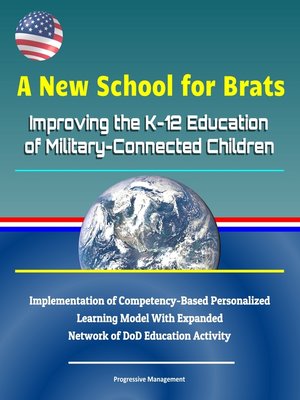A New School for Brats
ebook ∣ Improving the K-12 Education of Military-Connected Children--Implementation of Competency-Based Personalized Learning Model With Expanded Network of DoD Education Activity

Sign up to save your library
With an OverDrive account, you can save your favorite libraries for at-a-glance information about availability. Find out more about OverDrive accounts.
Find this title in Libby, the library reading app by OverDrive.



Search for a digital library with this title
Title found at these libraries:
| Library Name | Distance |
|---|---|
| Loading... |
This late 2017 report has been professionally converted for accurate flowing-text e-book format reproduction.
This thesis answers the question: How can recent changes in the educational environment be leveraged to improve K-12 education for military-connected children? In 2011, the Obama Administration issued a report, Strengthening Our Military Families, in which the president, the vice president, and every member of the president's cabinet committed to ensuring the well-being of military families, including the education of military-connected children. This study examines the current American public school system and its reliance on the traditional "factory-based" education model to determine the system's efficacy in educating military-connected children, a student population with unique academic, social, physical, and psychological challenges. Rather than depending on the traditional education model to educate military-connected children, this study recommends the implementation of a competency-based personalized learning model— strengthened by technology—within an expanded domestic network of the United States Department of Defense Education Activity to improve the K-12 education of military-connected children.
I. INTRODUCTION * A. THESIS QUESTION * B. DISCUSSION * C. SIGNIFICANCE OF THE THESIS QUESTION * D. LITERATURE REVIEW * 1. Technology in the Classroom * 2. The Challenges of Military-Connected Children * E. RESEARCH DESIGN * II. BACKGROUND * A. THE EVOLUTION OF AMERICAN PUBLIC SCHOOLS * 1. 1770-1900 * 2. 1900-1950 * 3. 1950-1980 * 4. 1980-Present * B. EDUCATION REFORM SINCE 2001 * 1. No Child Left Behind * 2. Common Core State Standards * 3. Race to the Top * 4. Every Student Succeeds Act * 5. Education Governance * C. THE TRADITIONAL SCHOOL MODEL * D. CONCLUSION * III. COMPETENCY-BASED, PERSONALIZED LEARNING STRENGTHENED BY TECHNOLOGY TO IMPROVE THE K-12 EDUCATION OF MILITARY-CONNECTED CHILDREN * A. COMPETENCY-BASED LEARNING * B. PERSONALIZED LEARNING * C. BLENDED LEARNING * D. MILITARY-CONNECTED CHILDREN AS NONCONSUMERS * IV. EXPANSION OF DEPARTMENT OF DEFENSE EDUCATION ACTIVITY SCHOOL SYSTEM * A. STANDARDIZED CURRICULUM WITHIN DEPARTMENT OF DEFENSE EDUCATION ACTIVITY SCHOOLS * 1. A Standardized Curriculum Based on International Benchmarks * 2. Benefits of Standardization to Military Families * B. THE EFFECTIVE INTEGRATION OF TECHNOLOGY INTO DEPARTMENT OF DEFENSE EDUCATION ACTIVITY SCHOOLS * 1. Blended Learning within the Department of Defense Education Activity * 2. Highly Mobile Educational Interfaces for Highly Mobile Students * 3. Using Technology to Redesign Assessments * C. THE ROLE OF TEACHERS IN DEPARTMENT OF DEFENSE EDUCATION ACTIVITY SCHOOLS * D. CONCLUSION * V. POLICY RECOMMENDATIONS * A. FULFILL THE MANDATE OF STRENGTHENING OUR MILITARY FAMILIES * B. INCREASE THE NUMBER OF SCHOOLS IN DODEA AMERICAS * C. SECURE FUNDING * D. SECURE AND TRAIN TEACHERS, FACULTY, AND ADMINISTRATORS * E. SECURE ON-BASE FACILITIES * F. INFORM MILITARY FAMILIES * G. CHOOSE CLASSROOM DESIGN * H. INCORPORATE APPROPRIATE EDUCATION TECHNOLOGY







